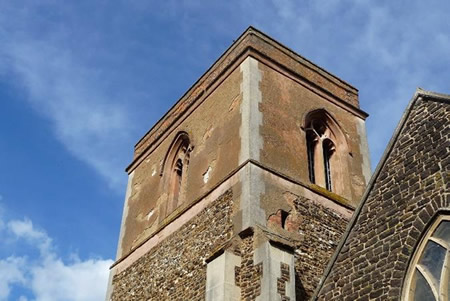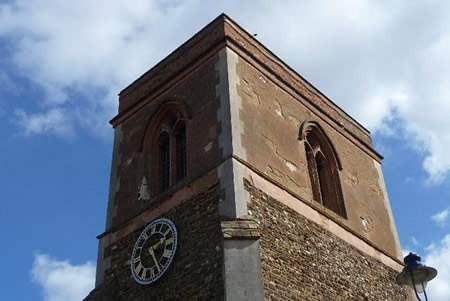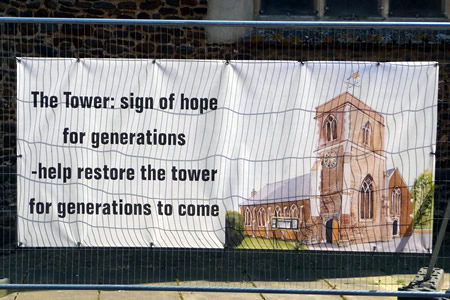St Michael and All Angels, Shefford
The tower of St Michael and All Angels stands ‘loud and proud’ in the centre of Shefford, with the widening High Street and junction to the east giving fine views of the church.
In 2011 the poor condition of the sides of the tower was picked up by the quinquennial inspection report. Two years later the church faced a ‘tower crisis’: loose render and falling masonry had to be taken down and scaffolding and a safety fence put up to protect visitors and passers-by.


The Parochial Church Council responded to the ‘tower crisis’ by commissioning a new QI report and employing a church surveyor to support a Heritage Lottery Fund grant bid. A successful Grant for Places of Worship application was made (before that scheme ended) and Shefford is now half way through the journey from crisis to conservation. It has already learnt important lessons which will benefit others who are facing daunting repairs and seeking HLF grants and other funding.
Shefford’s grant journey started with agreeing what the project would include and sending a completed project enquiry form to the HLF for its feedback. The challenge of writing the first-stage application followed and in March 2017 this was passed and a provisional award of £240,000 made towards the total cost of £333,000.
The project involves the removal of damaging materials from the tower and belfry followed by sympathetic repairs, a new disability-friendly entrance lobby and LED lights to improve the welcome and experience of the church. There was also a range of proposals to help people find out about, get involved in and discover their heritage (as required by the HLF). These included a church history booklet and pop-up interpretation banners, a Heritage Day and guided tours, and a participative booklet for children linked to the National Curriculum. A town heritage trail and heritage information on the church website were further ideas.

The next year was spent developing the project with detailed investigations of the tower before the second-stage application was made in March 2018. If that is successful as hoped then the work can begin!
The churchwardens Pat Goulding and Jennifer Forrester have been at the centre of the project and shared what helped them make good progress.
Choosing the right professional adviser who is a good match for your team, project and grant bids is crucial (the selection has to be competitive to satisfy the HLF). The architect or surveyor has to have relevant conservation experience and be genuinely interested in your project. You must be able to get on with and rely on them and have a positive and professional client-adviser relationship. You also need to know what their fees cover and what extra help they will give – say a quick consultation – without paying more.
The HLF application process has been quite a challenge and needed focus and stamina. Pat and Jennifer were part of a small group - the Tower Committee – who developed the application and explained it to and got feedback from the PCC as they went along. With the support of this group they absorbed themselves in HLF guidance and the information needed, and got to understand what the HLF was looking for (the ‘bells to ring’ and the words to use). This proved an effective way of working. Input from a range of other people was also key.
Pat and Jennifer strongly felt that reading someone else’s completed application was a great way of getting on the right track. They saw the successful HLF application from St Mary the Virgin, Baldock (featured here as another success story) and very much appreciated churchwarden Phil Charsley’s experience and advice.
The mentor provided by the HLF to support the church through the development phase has been very helpful and the special expertise of others in the town or linked to the churchwardens and parish have been invaluable. Going to the DAC meeting was also very useful and helped the churchwardens learn about faculty permissions from a standing start.
It was important to apply for grants from a number of funders as well as the HLF. This filled the gap between the cost of the project and what the HLF would offer and showed the HLF that the church was positive and full of energy rather than ‘sitting on its backside’ and ‘waiting for a handout’. Getting other grants with different payment times, along with the church reserve, also made managing the all-important cash flow easier.
Keeping going with grant bids is a good habit which will help fund future much-needed work and could be a special role for a volunteer. To date successful applications have been made to the Beds and Herts Historic Churches Trust, the Gale Family Trust, the Steel Charitable Trust, the Francis Coales Charitable Foundation and the Allchurches Trust Ltd. The Robert Lucas Trust is funding the bell restoration.
Shefford is not a particularly wealthy town and the church is not surrounded by large houses occupied by ‘high-wealth individuals’. But it does benefit from its town-centre location and the number of people coming into the church (100 every week) and walking past. A survey of passers-by flagged up the local interest in the church and its potential and was used to support the HLF application. Judy, a member of the Tower Committee, wrote articles for each edition of Shefford Newsline – a quarterly magazine delivered free to all houses in the town.
Collecting money for the project in jam jars in the church and around the town has so far raised £2,000 – total fundraising and local donations amounts to over £13,000. Such local fundraising has pulled in wide-spread support and highlighted the fantastic value of the church and its repair, improvement and heritage project. It has shown how much the community appreciate its church.
For more information contact Patricia Goulding at This email address is being protected from spambots. You need JavaScript enabled to view it..

